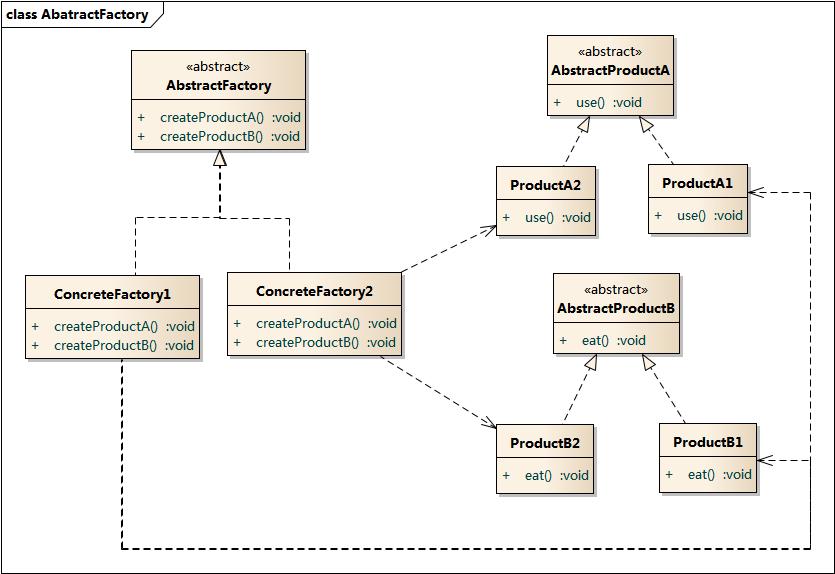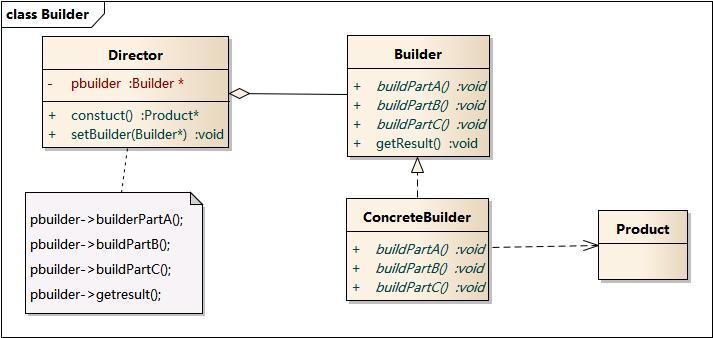第 2 章 JAVA设计模式
2.1 JAVA反射技术
-
Java反射技术应用广泛,它能够配置:类的全限定名、方法和参数,完成对象的初始化,甚至是反射某些方法
-
在Java中,反射是通过包
java.lang.reflect.*来实现的
2.1.1 通过反射构建对象
-
Java中允许通过反射配置信息构建对象
-
示例一: 通过反射构建无参数的实例
-
ReflectServiceImpl: 我们要构建的类
1
2
3
4
5public class ReflectServiceImpl{
public void sayHello(String name){
System.out.println("Hello, " + name);
}
} -
反射生成对象的方式
1
2
3
4
5
6
7
8
9
10public ReflectServiceImpl getInstance(){
ReflectServiceImpl object = null;
try{
//给类加载器注册了一个类ReflectServiceImpl的全限定名,然后通过newInstance方法初始化一个对象
object = (ReflectServiceImpl)Class.forName("com.edu.neu.ReflectServiceImpl").newInstance();
}catch(ClassNotFoundException | InstantiationException | IllegalAccessException ex){
ex.printStackTrace();
}
return object;
}
-
-
示例二: 通过反射构建有参数的实例
-
ReflectServiceImpl2: 构造方法含有参数的类
1
2
3
4
5
6
7
8
9public class ReflectServiceImpl2{
private String name;
public ReflectServiceImpl2(String name){
this.name = name;
}
public void sayHello(){
System.out.println("hello " + name);
}
} -
通过反射生成带有参数的构造方法
1
2
3
4
5
6
7
8
9
10public ReflectServiceImpl2 getInstance(){
ReflectServiceImpl2 object = null;
try{
//先通过forName加载到类的加载器。然后通过getConstructor方法,它的参数可以是多个,这里定义为String.class,意为有且只有一个参数类型为String的构造方法
object = (ReflectServiceImpl2)Class.forName("com.edu.neu.ReflectServiceImpl2").getConstructor(String,class).newInstance("张三");
}catch(ClassNotFoundException | InstantiationException | IllegalAccessException | NoSuchMethodException | SecurityException | IllegalArgumentException | InvocationTargetException ex){
ex.printStackTrace();
}
return object;
}
-
-
反射的优点: 只要配置就可以生成对象,可以解除程序的耦合度,比较灵活
-
反射的缺点: 运行比较慢
2.1.2 反射方法
-
下面讲解如何使用反射机制调用方法
-
示例: 获取和反射方法
1
2
3
4
5
6
7
8
9
10
11public Object reflectMethod(){
Object returnObj = null;
ReflectServiceImpl tatget = new ReflectServiceImpl();
try{
Method method = ReflectServiceImpl.class.getMethod("sayHello", String.class);
returnObj = method.invoke(target, "张三");
}catch(ClassNotFoundException | InstantiationException | IllegalAccessException | NoSuchMethodException | SecurityException | IllegalArgumentException | InvocationTargetException ex){
ex.printStackTrace();
}
return returnObj;
}
2.1.3 实例
-
示例: 如何通过反射生成对象和反射调用方法
1
2
3
4
5
6
7
8
9
10
11public Object reflect(){
ReflectServiceImpl object = null;
try{
object = (ReflectServiceImpl)Class.forName("com.edu.neu.ReflectServiceImpl").newInstance();
Method method = object.getClass().getMethod("sayHello", String,class);
method.invoke(object, "张三");
}catch(ClassNotFoundException | InstantiationException | IllegalAccessException | NoSuchMethodException | SecurityException | IllegalArgumentException | InvocationTargetException ex){
ex.printStackTrace();
}
return object;
} -
对象在反射机制下生成后,反射了方法,这样我们完全可以通过配置来完成对象和方法的反射,大大增加了Java的可配置性和可扩展性,其中
Spring IoC就是一个典型的例子
2.2 动态代理模式和责任链模式
-
动态代理的意义在于生成一个占位(又称代理对象),来代理真实对象,从而控制对真实对象的访问
-
代理的作用就是,在真实对象访问之前或之后加入对应的逻辑,或者根据其他规则控制是否使用真实对象,显然在这个例子中商务控制了客户对软件工程师的访问
-
示例
-
我们需要在调用调用对象之前产生一个代理对象,而这个代理对象需要和真实对象建立起代理关系,所以代理对象分为两步
- 代理对象和真实对象建立代理关系
- 实现代理对象的代理逻辑技术
-
常见的动态代理技术
- JDK
- CGLIB
- Javassist
- ASM
2.2.1 JDK动态代理
-
简介: JDK动态代理是
java.lang.reflect.*包提供的方式,它必须借助一个接口才能产生代理对象 -
示例代码:使用JDK动态代理
-
定义
HelloWorld接口1
2
3public interface HelloWorld {
void sayHelloWorld();
} -
定义
HelloWorldImpl类实现HelloWorld接口,这个类充当真实对象的角色1
2
3
4
5
6
7public class HelloWorldImpl implements HelloWorld{
public void sayHelloWorld() {
System.out.println("Hello World");
}
} -
定义
JdkProxyExample类来实现java.lang.reflect.InvocationHandler接口,这个类用来动态绑定代理和实现代理逻辑1
2
3
4
5
6
7
8
9
10
11
12
13
14
15
16
17
18
19
20
21
22
23
24
25
26
27
28
29
30
31
32
33
34import java.lang.reflect.InvocationHandler;
import java.lang.reflect.Method;
import java.lang.reflect.Proxy;
public class JdkProxyExample implements InvocationHandler {
private Object target = null;
/**
* 建立代理对象和真实对象的代理关系,并返回代理对象
* @param target 真实对象
* @return 代理对象
* */
public Object bind(Object target) {
this.target = target;
return Proxy.newProxyInstance(target.getClass().getClassLoader(), target.getClass().getInterfaces(), this);
}
/**
* 代理方法逻辑
* @param proxy 代理对象
* @param method 当前调用方法
* @param args 当前方法参数
* @return java.lang.Object 代理结果返回
* @author t0ugh
* @date 2019/4/23 16:26
*/
public Object invoke(Object proxy, Method method, Object[] args) throws Throwable {
System.out.println("进入代理逻辑方法");
System.out.println("在调度真实对象之前的服务");
Object obj = method.invoke(target, args);
System.out.println("在调度真实对象之后的服务");
return obj;
}
}- 程序主入口,测试JDK动态代理
1
2
3
4
5
6
7public class Main {
public static void main(String[] args) {
JdkProxyExample jdk = new JdkProxyExample();
HelloWorld proxy = (HelloWorld)jdk.bind(new HelloWorldImpl());
proxy.sayHelloWorld();
}
}
-
-
代码解读(
JdkProxyExample类)- 建立代理对象和真实对象的关系
- 这里使用
bind方法完成,方法里首先用类的属性target保存了真实对象,并且调用Proxy.newProxyInstace建立并生成了代理对象 newProxyInstance方法包含3个参数- 第1个是类加载器,我们采用了
target本身的类加载器。 - 第2个是把生成的动态代理对象下挂在哪些接口下,这个写法就是放在
target实现的接口下。HelloWorldlmpl对象的接口显然就是HelloWorld - 第3个是定义实现方法逻辑的代理类,
this表示当前对象,它必须实现InvocationHandler接口的invoke方法,它就是代理逻辑方法的现实方法。
- 第1个是类加载器,我们采用了
- 这里使用
- 实现代理逻辑方法
invoke方法可以实现代理逻辑invoke方法的三个参数如下proxy, 代理对象,也就是通过bind方法生成的对象method, 当前调度的方法args,调度方法的参数
- 建立代理对象和真实对象的关系
-
类比前面的例子
- proxy 相当于商务
- target 相当于软件工程师
- bind 方法就是建立商务和软件工程师代理关系的方法
- invoke,相当于商务逻辑,它控制对软件工程师的访问
2.2.2 CGLIB动态代理
-
CGLIB动态代理的优势在于它不需要提供接口,只要一个非抽象类就可以实现动态代理
-
示例代码: CGLIB动态代理
1
2
3
4
5
6
7
8
9
10
11
12
13
14
15
16
17
18
19
20
21
22
23
24
25
26
27
28
29
30
31
32
33
34
35
36
37
38
39public class CglibProxyExample implements MethodInterceptor{
/**
* 生成CGLIB代理对象
* @param cls Class类
* @return Class类的CGLIB代理对象
*/
public Object getProxy(Class cls){
//CGLIB enhancer增强类对象
Enhancer enhancer = new Enhancer();
//设置增强类型
enhancer.setSuperclass(cls);
//定义代理逻辑对象为当前对象,要求当前对象实现MethodInterceptor接口
enhancer.setCallback(this);
//生成并返回代理对象
return enhancer.create();
}
/**
* 代理逻辑方法
* @param proxy 代理对象
* @param method 方法
* @param args 方法参数
* @param methodProxy 方法代理
*/
public Object intercept(Object proxy, Method method, Object[] args, MethodProxy methodProxy) throws Throwable{
System.out.println("调用真实对象前");
//CGLIB反射调用真实对象
Object result = methodProxy.invokeSuper(proxy, args);
System.out.println("调用真实对象后");
return result;
}
}
public class Main {
public static void main(String[] args) {
CglibProxyExample cpe = new CglibProxyExample();
ReflectServiceImpl obj = (ReflectServiceImpl)cpe.getProxy(ReflectServiceImpl.class);
obj.sayHello("张三");
}
} -
概括: JDK动态代理和CGLIB动态代理都是通过
getProxy方法生成代理对象,制定代理的逻辑类。而代理的逻辑类要实现一个接口的一个方法,这个方法就是代理对象的逻辑方法,它可以控制真实对象的方法
2.2.3 拦截器
-
拦截器可以进一步简化动态代理的使用方法,使程序变得更简单
- 开发者只要知道拦截器的作用就可以编写拦截器,编写完后可以设置拦截器,这样就完成了任务,所以对于开发者来说相对简单了
- 设计者可能是精通java的开发人员,他来完成动态代理的逻辑
- 设计者只会把拦截器接口暴露给开发者使用,让动态代理的逻辑在开发者的视野中“消失”
-
示例:使用JDK实现一个拦截器
-
定义拦截器接口
Interceptor,通常存在于类库中,由类库的设计人员实现1
2
3
4
5
6
7
8
9
10
11
12
13
14import java.lang.reflect.Method;
/**
* @author t0ugh
* @version 1.0
* @date 2019/4/24 20:11
*/
public interface Interceptor {
public boolean before(Object proxy, Object target, Method method, Object[] args);
public void around(Object proxy, Object target, Method method, Object[] args);
public void after(Object proxy, Object target, Method method, Object[] args);
}before方法: 返回boolean值,它在真实对象前调用。当返回true时,则反射真实对象的方法;当返回为false时,则调用around方法around方法: 当before方法返回为false时,执行around方法- 在反射真实对象方法或者
around方法执行之后,调用after方法
-
定义一个
Interceptor接口的实现类,由开发人员实现,来控制对真实对象的访问,这里只是随便实现一个比较简单的没有任何功能的Interceptor1
2
3
4
5
6
7
8
9
10
11
12
13
14
15
16
17
18
19
20
21
22
23
24
25import java.lang.reflect.Method;
/**
* @author t0ugh
* @version 1.0
* @date 2019/4/24 20:14
*/
public class MyInterceptor implements Interceptor{
public boolean before(Object proxy, Object target, Method method, Object[] args) {
System.out.println("反射方法前逻辑");
return false;
}
public void around(Object proxy, Object target, Method method, Object[] args) {
System.out.println("取代了被代理对象的方法");
}
public void after(Object proxy, Object target, Method method, Object[] args) {
System.out.println("反射方法后逻辑");
}
} -
在JDK动态代理中使用拦截器,由类库的设计者实现,对程序开发人员透明
1
2
3
4
5
6
7
8
9
10
11
12
13
14
15
16
17
18
19
20
21
22
23
24
25
26
27
28
29
30
31
32
33
34
35
36
37
38
39
40
41
42
43
44
45
46
47
48
49
50
51
52
53
54
55
56
57import java.lang.reflect.InvocationHandler;
import java.lang.reflect.Method;
import java.lang.reflect.Proxy;
/**
* @author t0ugh
* @version 1.0
* @date 2019/4/24 20:16
*/
public class InterceptorJdkProxy implements InvocationHandler {
private Object target;//真实对象
private String interceptorClass = null;//拦截器全限定名
public InterceptorJdkProxy(Object target, String interceptorClass) {
this.target = target;
this.interceptorClass = interceptorClass;
}
/**
* 绑定委托对象并返回一个[代理占位]
* @param target 真实对象
* @param interceptorClass 实现了InvocationHandler的类
* @return 代理对象[占位]
*/
public static Object bind(Object target, String interceptorClass){
return Proxy.newProxyInstance(target.getClass().getClassLoader(), target.getClass().getInterfaces(), new InterceptorJdkProxy(target, interceptorClass));
}
/***
* 通过代理对象调用方法, 首先进入这个方法
* @param proxy 代理对象
* @param method 方法,被调用的方法
* @param args 方法的参数
* @return
* @throws Throwable
*/
public Object invoke(Object proxy, Method method, Object[] args) throws Throwable {
if(interceptorClass == null){
//没有设置拦截器则直接反射原有的方法
return method.invoke(target, args);
}
Object result = null;
//通过反射生成拦截器
Interceptor interceptor = (Interceptor) Class.forName(interceptorClass).newInstance();
//调用前置方法
if(interceptor.before(proxy, target, method, args)){
//反射原有的方法
result = method.invoke(target, args);
}else{//假如返回false执行around方法
interceptor.around(proxy, target, method, args);
}
//调用后置方法
interceptor.after(proxy, target, method, args);
return result;
}
}- 执行步骤(针对上文
InterceptorProxy类)- 在bind 方法中用JDK 动态代理绑定了一个对象,然后返回代理对象。
- 如果没有设置拦截器, 则直接反射真实对象的方法,然后结束,否则进行第 3 步。
- 通过反射生成拦截器,并准备使用它。
- 调用拦截器的before 方法,如果返回为true ,反射原来的方法;否则运行拦截器的around 方法。
- 调用拦截器的after 方法。
- 返回结果。
- 执行步骤(针对上文
-
测试拦截器:可以看出,比手动实现Proxy的方式更加简单了
1
2
3
4
5
6
7
8
9
10
11
12
13
14import ReflectDemo.JDKProxy.HelloWorld;
import ReflectDemo.JDKProxy.HelloWorldImpl;
/**
* @author t0ugh
* @version 1.0
* @date 2019/4/24 20:32
*/
public class Main {
public static void main(String[] args) {
HelloWorld proxy = (HelloWorld) InterceptorJdkProxy.bind(new HelloWorldImpl(), "InterceptorDemo.MyInterceptor");
proxy.sayHelloWorld();
}
}
-
-
拦截器的工作流程图
2.2.4 责任链模式
-
责任链模式
- 当一个对象在一个链上被多个拦截器拦截处理(拦截器也可以选择不拦截处理它)时,我们把这种设计模式称为责任链模式
- 可以考虑用层层代理的方式来实现这种模式
- 拦截逻辑如下图
-
示例:使用层层代理的方式实现责任链模式
-
定义3个拦截器
1
2
3
4
5
6
7
8
9
10
11
12
13
14
15
16
17
18
19
20
21
22
23
24
25
26
27
28
29
30
31
32public class Interceptor1 implements Interceptor{
public boolean before (Object proxy, Object target , Method method , Object [] args){
System.out.println("拦截器1的before方法");
return true;
}
public void around(Object proxy, Object target, Method method, Object [] args){}
public void after (Object proxy, Object target, Method method, Object [] args){
System.out.println("拦截器1的after方法");
}
}
public class Interceptor2 implements Interceptor{
public boolean before (Object proxy, Object target , Method method , Object [] args){
System.out.println("拦截器2的before方法");
return true;
}
public void around(Object proxy, Object target, Method method, Object [] args){}
public void after (Object proxy, Object target, Method method, Object [] args){
System.out.println("拦截器2的after方法");
}
}
public class Interceptor3 implements Interceptor{
public boolean before (Object proxy, Object target , Method method , Object [] args){
System.out.println("拦截器3的before方法");
return true;
}
public void around(Object proxy, Object target, Method method, Object [] args){}
public void after (Object proxy, Object target, Method method, Object [] args){
System.out.println("拦截器3的after方法");
}
} -
测试责任链模式上的多拦截器
1
2
3
4
5
6public static void main(String[] args) {
HelloWorld proxy1 = (HelloWorld)InterceptorJdkProxy.bind(new HelloWorldimpl(), "interceptor.Interceptorl");
HelloWorld proxy2 = (HelloWorld)InterceptorJdkProxy.bind(proxy1, "interceptor.Interceptor2");
HelloWorld proxy3 = (HelloWorld)InterceptorJdkProxy.bind(proxy2, "interceptor.Interceptor3");
proxy3.sayHelloWorld() ;
}before方法按照从最后一个拦截器都第一个拦截器的加载顺序运行after方法按照从第一个拦截器到最后一个拦截器的加载顺序运行
-
-
责任链模式的优缺点
- 优点:可以在传递链上加入新的拦截器,增加拦截逻辑
- 缺点:会增加代理和反射,而代理和反射的性能不高
2.3 观察者模式
-
观察者模式
- 又称为发布订阅模式,是对象的行为模式
- 观察者模式定义了一种一对多的依赖关系,让多个观察者对象同时监视着被观察者的状态,当被观察者的状态发生变化时,会通知所有观察者,并让其自动更新自己
- 被观察者是自变量而观察者是因变量
-
示例:如何使用JDK中的观察者模式
-
继承类库中的Observable类,定义一个被观察者
1
2
3
4
5
6
7
8
9
10
11
12
13
14
15
16
17
18
19
20
21
22
23
24
25
26
27
28
29
30
31
32import java.util.ArrayList;
import java.util.List;
import java.util.Observable;
/**
* @author t0ugh
* @version 1.0
* @date 2019/4/24 21:22
*/
public class ProductList extends Observable {
private List<String> productList = null;
private static ProductList instance;
private ProductList() {
}
public static ProductList getInstance(){
if(instance == null){
instance = new ProductList();
instance.productList = new ArrayList<>();
}
return instance;
}
public void addProduct(String newProduct){
productList.add(newProduct);
System.out.println("产品列表增加了: " + newProduct);
this.setChanged();
this.notifyObservers(newProduct);
}
} -
实现类库中的Observer接口,定义两个被观察者
1
2
3
4
5
6
7
8
9
10
11
12
13
14
15import java.util.Observable;
import java.util.Observer;
/**
* @author t0ugh
* @version 1.0
* @date 2019/4/24 21:27
*/
public class JingDongObserver implements Observer {
public void update(Observable o, Object product) {
String newProduct = (String) product;
System.out.println("发布了新产品: " + newProduct + ",已加入京东");
}
}1
2
3
4
5
6
7
8
9
10
11
12
13
14
15import java.util.Observable;
import java.util.Observer;
/**
* @author t0ugh
* @version 1.0
* @date 2019/4/24 21:28
*/
public class TaoBaoObserver implements Observer {
public void update(Observable o, Object product) {
String newProduct = (String) product;
System.out.println("发布了新产品: " + newProduct + ",已加入淘宝");
}
} -
测试观察者模式
1
2
3
4
5
6
7
8
9
10
11
12
13
14
15
16
17
18
19
20
21
22
23
24
25
26
27
28
29
30
31
32
33
34
35
36
37
38
39
40
41
42
43
44
45
46
47
48
49
50
51
52
53
54
55/**
* @author t0ugh
* @version 1.0
* @date 2019/4/24 21:30
*/
public class Main {
public static void main(String[] args) {
ProductList productList =ProductList.getInstance();
productList.addObserver(new JingDongObserver());
productList.addObserver(new TaoBaoObserver());
productList.addProduct("呆滞牌夹心饼干");
}
}
````### 2.3 观察者模式
- 观察者模式
- 又称为发布订阅模式,是对象的行为模式
- 观察者模式定义了一种一对多的依赖关系,让多个观察者对象同时监视着被观察者的状态,当被观察者的状态发生变化时,会通知所有观察者,并让其自动更新自己
- 被观察者是自变量而观察者是因变量
- 示例:如何使用JDK中的观察者模式
1. 继承类库中的Observable类,定义一个被观察者
````java
import java.util.ArrayList;
import java.util.List;
import java.util.Observable;
/**
* @author t0ugh
* @version 1.0
* @date 2019/4/24 21:22
*/
public class ProductList extends Observable {
private List<String> productList = null;
private static ProductList instance;
private ProductList() {
}
public static ProductList getInstance(){
if(instance == null){
instance = new ProductList();
instance.productList = new ArrayList<>();
}
return instance;
}
public void addProduct(String newProduct){
productList.add(newProduct);
System.out.println("产品列表增加了: " + newProduct);
this.setChanged();
this.notifyObservers(newProduct);
}
} -
实现类库中的Observer接口,定义两个被观察者
1
2
3
4
5
6
7
8
9
10
11
12
13
14
15import java.util.Observable;
import java.util.Observer;
/**
* @author t0ugh
* @version 1.0
* @date 2019/4/24 21:27
*/
public class JingDongObserver implements Observer {
public void update(Observable o, Object product) {
String newProduct = (String) product;
System.out.println("发布了新产品: " + newProduct + ",已加入京东");
}
}1
2
3
4
5
6
7
8
9
10
11
12
13
14
15import java.util.Observable;
import java.util.Observer;
/**
* @author t0ugh
* @version 1.0
* @date 2019/4/24 21:28
*/
public class TaoBaoObserver implements Observer {
public void update(Observable o, Object product) {
String newProduct = (String) product;
System.out.println("发布了新产品: " + newProduct + ",已加入淘宝");
}
} -
测试观察者模式
1
2
3
4
5
6
7
8
9
10
11
12
13/**
* @author t0ugh
* @version 1.0
* @date 2019/4/24 21:30
*/
public class Main {
public static void main(String[] args) {
ProductList productList =ProductList.getInstance();
productList.addObserver(new JingDongObserver());
productList.addObserver(new TaoBaoObserver());
productList.addProduct("呆滞牌夹心饼干");
}
}
-
2.4 工厂模式和抽象工厂模式
2.4.1 普通工厂(Simple Factory)模式
-
简介
- 在简单工厂模式中,可以根据参数的不同返回不同类的实例
- 简单工厂模式专门定义一个类来负责创建其他类的实例,被创建的实例通常都具有共同的父类。
-
模式结构
Factory(工厂角色): 工厂角色负责实现创建所有实例的内部逻辑Product(抽象产品角色): 抽象产品角色是创建的所有产品的父类,负责描述所有实例所共有的公共接口ConcreteProduct(具体产品角色): 具体产品角色是创建目标,所有创建的对象都充当了这个角色的某个具体类的实例
-
类图

-
时序图

2.4.2 抽象工厂(Abstract Factory)模式
-
简介:
- 提供一个创建一系列相关或相互依赖对象的接口,而无须指定它们具体的类。
- 抽象工厂模式又称为Kit模式,属于对象创建型模式。
- 用于生产一个产品族的产品
-
模式结构
- AbstractFactory:抽象工厂
- ConcreteFactory:具体工厂
- AbstractProduct:抽象产品
- Product:具体产品
-
类图

-
时序图

2.5 建造者模式
-
简介
- 建造者模式可以将部件和其组装过程分开,一步一步创建一个复杂的对象。用户只需要指定复杂对象的类型就可以得到该对象,而无须知道其内部的具体构造细节。
- 建造者模式是一步一步创建一个复杂的对象,它允许用户只通过指定复杂对象的类型和内容就可以构建它们,用户不需要知道内部的具体构建细节。建造者模式属于对象创建型模式。根据中文翻译的不同,建造者模式又可以称为生成器模式。
-
模式结构
- Builder:抽象建造者
- ConcreteBuilder:具体建造者
- Director:指挥者
- Product:产品角色
-
类图

-
时序图

